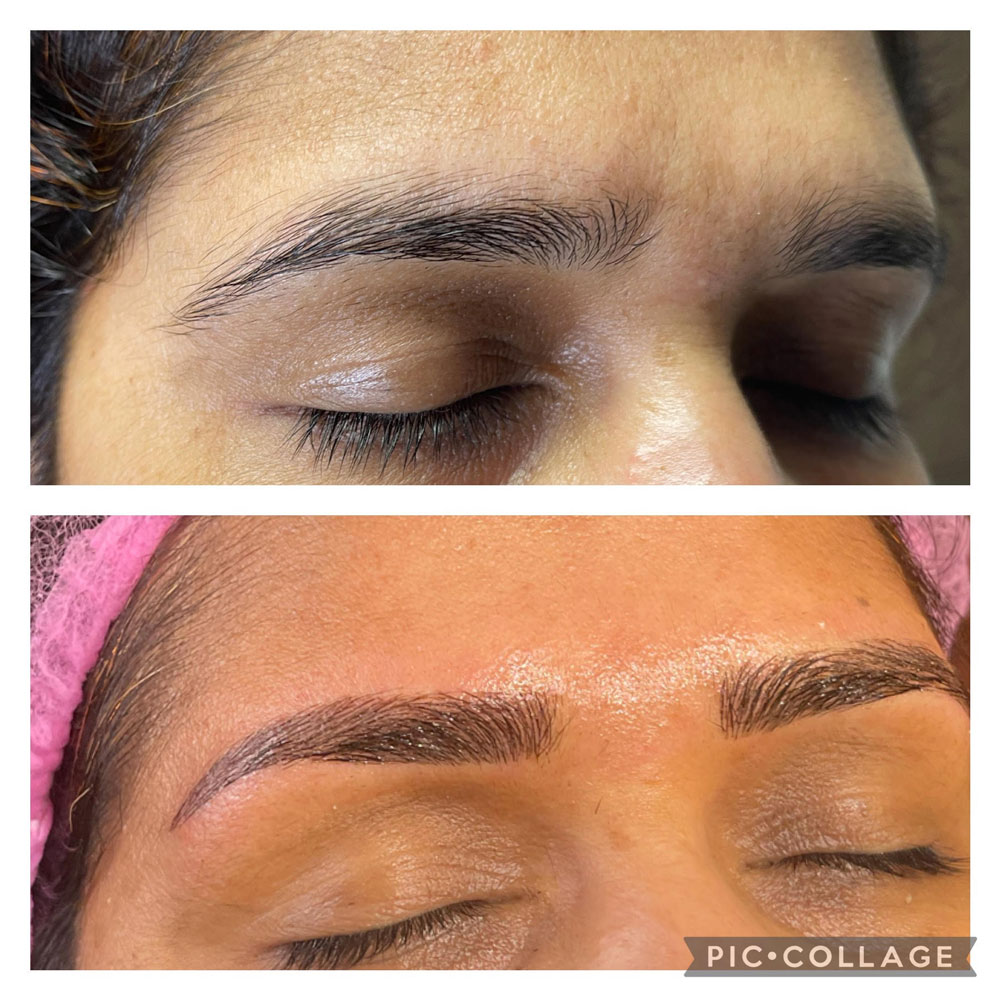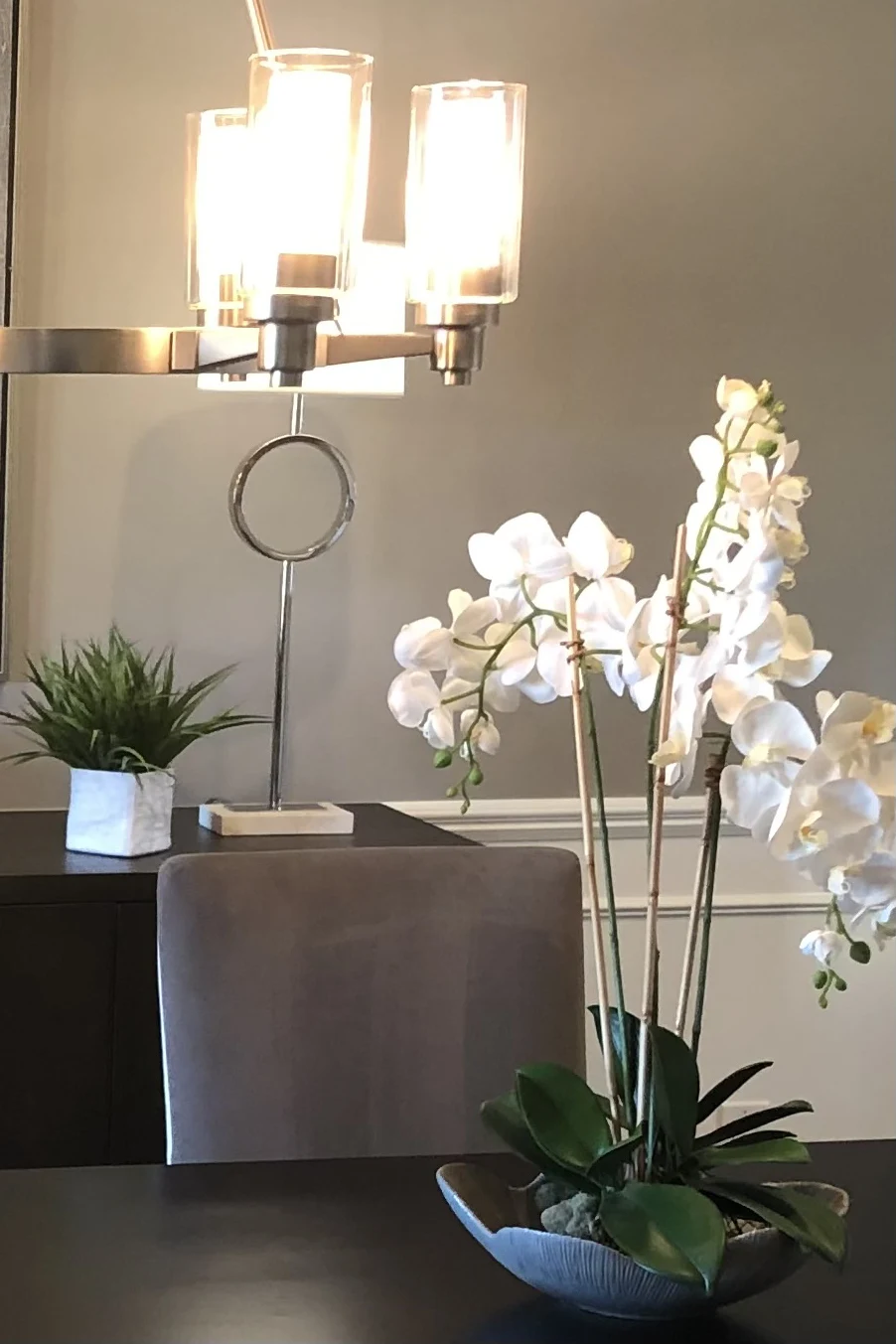Microblading is a semi-permanent cosmetic tattooing technique used to enhance the appearance of eyebrows. It involves manually depositing pigment into the upper layers of the skin to create hair-like strokes that mimic the natural look of eyebrows. The goal of microblading is to achieve fuller, more defined eyebrows that appear natural and symmetrical.

You’ll start with a consultation where you discuss your desired eyebrow shape and thickness with a trained microblading artist. They will also consider your facial features and skin tone to create a customized look.
The artist will use a pencil to draw the desired eyebrow shape directly onto your skin. This step ensures that you and the artist are on the same page regarding the final result
Before the microblading procedure begins, a topical numbing cream is applied to the area to minimize discomfort. This helps to make the process more comfortable for the client.
Using a specialized microblading tool, the artist creates small, precise incisions in the skin’s surface and deposits pigment into them. These strokes mimic the appearance of individual eyebrow hairs, resulting in a natural and realistic look.
The artist will choose a pigment color that matches your natural eyebrow color or complements your hair color and skin tone.
After the microblading session, the eyebrows may appear darker and more intense than desired. Over the next few days, the pigment will oxidize and settle into a more natural color. It’s normal for the treated area to go through a healing process, which includes scabbing and slight flaking.
:
Proper aftercare is crucial for optimal results. This may involve avoiding excessive moisture, sunlight, and makeup on the treated area during the healing process
Microblading typically requires a touch-up session after a few weeks. During this session, the artist can refine the shape and color of the brows and fill in any areas where the pigment did not take well during the initial session.
Microblading results can last anywhere from 1 to 3 years, depending on factors such as skin type, lifestyle, and exposure to the elements. Periodic touch-up sessions are recommended to maintain the desired appearance.
Eyebrow Shading, also known as Ombre Brows, is another popular technique that is done alone or in combination with microblading to enhance the appearance of eyebrows through semi-permanent makeup. Unlike microblading, which creates individual hair-like strokes, Eyebrow Shading creates a soft, shaded, and gradient effect that resembles the look of filled-in eyebrows achieved with makeup.
Eyebrow Shading is a great choice for individuals who want a fuller and more defined brow look but prefer a gentler appearance compared to traditional microblading. It’s especially well-suited for those with sparse or thin eyebrows.

As with other eyebrow enhancement techniques, you’ll start with a consultation to discuss your preferences and desired eyebrow shape with the technician.
A topical numbing cream is applied to the eyebrow area to minimize discomfort during the procedure.
Using a handheld tool or a tattoo machine, the technician creates a series of small dots and lines that vary in density and intensity. These dots and lines are strategically placed to achieve a gradient effect, with the front of the brows appearing lighter and gradually becoming darker toward the tails.
: The technician selects a pigment color that matches your natural brow color or complements your hair and skin tone.
After the procedure, the brows might initially appear darker and more intense. However, as the skin heals, the color will soften and blend into a more natural appearance.
:
Proper aftercare is crucial for optimal results. This may involve avoiding excessive moisture, sunlight, and makeup on the treated area during the healing process
Microblading typically requires a touch-up session after a few weeks. During this session, the artist can refine the shape and color of the brows and fill in any areas where the pigment did not take well during the initial session.
Semi-permanent eyeliner, also known as permanent eyeliner or cosmetic tattoo eyeliner, is a procedure that involves depositing pigment along the lash line to create the appearance of defined and enhanced eyes. This technique is especially popular among individuals who want to save time on their daily makeup routine or have difficulty applying eyeliner.
You’ll start with a consultation with a trained cosmetic tattoo artist. During this discussion, you’ll talk about your desired eyeliner style, thickness, and color. The artist will also assess your eye shape and provide recommendations based on your preferences and features.
Before the procedure begins, a topical numbing cream is applied to the eyelid area to minimize any discomfort during the treatment.
Using a fine needle and a specialized tattoo machine, the technician carefully deposits pigment along the upper or lower lash line. The result can range from a subtle enhancement that mimics the appearance of fuller lashes to a more dramatic eyeliner look.
The artist selects a pigment color that complements your eye color and skin tone. The pigment is often chosen to create a natural yet enhanced appearance.
The eyeliner may appear darker and more intense than the final result. As the skin heals over the next few days to weeks, the color will soften and settle into a more natural appearance. Following proper aftercare instructions, such as avoiding makeup and excessive moisture, is crucial for optimal healing.
Like other semi-permanent makeup procedures, a touch-up session may be necessary after the initial treatment to perfect the color and shape. This touch-up is usually scheduled a few weeks after the initial procedure.
Lip blush, also known as lip tattooing or lip color tattoo, is a semi-permanent cosmetic procedure designed to enhance the appearance of the lips by adding color and definition. It aims to create the look of natural, subtly tinted lips with a soft gradient effect.
You’ll begin with a consultation with a trained cosmetic tattoo artist. During this consultation, you’ll discuss your desired lip color, shape, and style. The artist will take into account your natural lip color, skin tone, and facial features to create a customized look.
Before the procedure begins, a topical numbing cream is applied to the lips to minimize any discomfort.
Using a fine needle and a specialized tattoo machine, the technician deposits pigment into the top layers of the lips. This process creates a soft and natural-looking tint that enhances the color and definition of the lips
The artist will help you select a lip color that complements your skin tone and personal preferences. The goal is to create a shade that appears as if you’re wearing a subtle, everyday lip tint.
After the procedure, your lips may appear darker and more intense than the desired result. Over the next few days to weeks, the color will gradually soften and settle into a natural-looking tint. Following proper aftercare instructions, such as avoiding makeup and excessive moisture, is essential for optimal healing.
Touch-Ups: Similar to other semi-permanent makeup procedures, a touch-up session may be necessary after the initial treatment to perfect the color and ensure longevity. This touch-up session is usually scheduled a few weeks after the initial procedure.
Scalp micropigmentation (SMP) is a non-surgical cosmetic procedure that involves depositing pigments into the scalp to create the appearance of a closely shaved or buzzed hairstyle. It’s often used to address hair loss, thinning hair, receding hairlines, and other scalp-related concerns. SMP can effectively simulate the look of a full head of hair by replicating hair follicles or adding density to existing hair.
During this consultation, you’ll discuss your hair loss concerns, desired hairstyle, and expectations. The practitioner will evaluate your scalp and recommend a suitable approach.c
The practitioner will create a customized design based on your desired hairline, hair pattern, and overall appearance. This design will guide the placement of pigments on your scalp
Using a specialized micro-needle or tattoo machine, the practitioner meticulously deposits pigments into the upper layers of the scalp. These pigments replicate the appearance of hair follicles or add shading to create a natural-looking effect. The practitioner will adjust the pigment color to match your existing hair color or desired style.
Multiple layers of pigments may be applied to achieve depth and dimension, creating a more realistic appearance.
After the procedure, your scalp might appear slightly red and the pigmented areas may be darker than the intended result. Over the next few days to weeks, the pigments will settle and blend to create a more natural look. Proper aftercare, such as avoiding sun exposure and adhering to any post-procedure instructions, is important for optimal healing.
SMP is a long-lasting solution, but some fading can occur over time due to factors like sun exposure and skin changes. Depending on individual factors, you may need touch-up sessions every few years to maintain the desired appearance.
Scalp micropigmentation is a versatile option for both men and women seeking to address hair loss or create the illusion of thicker hair.

WhatsApp us